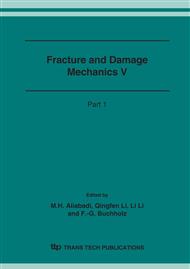p.1181
p.1185
p.1189
p.1193
p.1197
p.1201
p.1205
p.1209
p.1213
A Study on the Development of Reflective Photoelastic Experimental Hybrid Method on the Static Plane Problems of Orthotropic Material
Abstract:
The reflective photoelastic experimental hybrid method for the fracture mechanics of orthotropic material was developed in this research. it was verified that the reflective photoelastic experimental hybrid method was more useful for the static plane problems of fracture mechanics, for the determination of stress intensity factors and for the separation of stress components at the vicinity of the crack-tip than the transparent photoelastic experimental hybrid method in orthotropic materials.
Info:
Periodical:
Pages:
1197-1200
Citation:
Online since:
November 2006
Authors:
Price:
Сopyright:
© 2006 Trans Tech Publications Ltd. All Rights Reserved
Share:
Citation:


